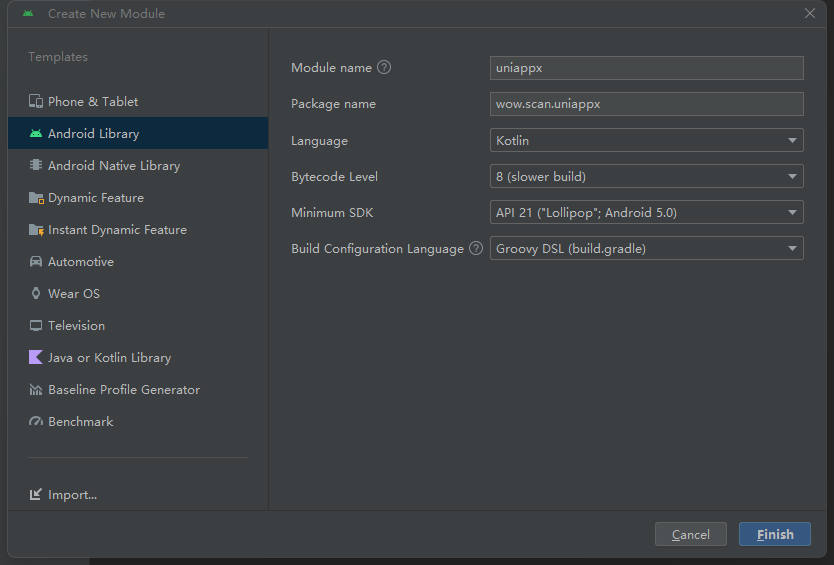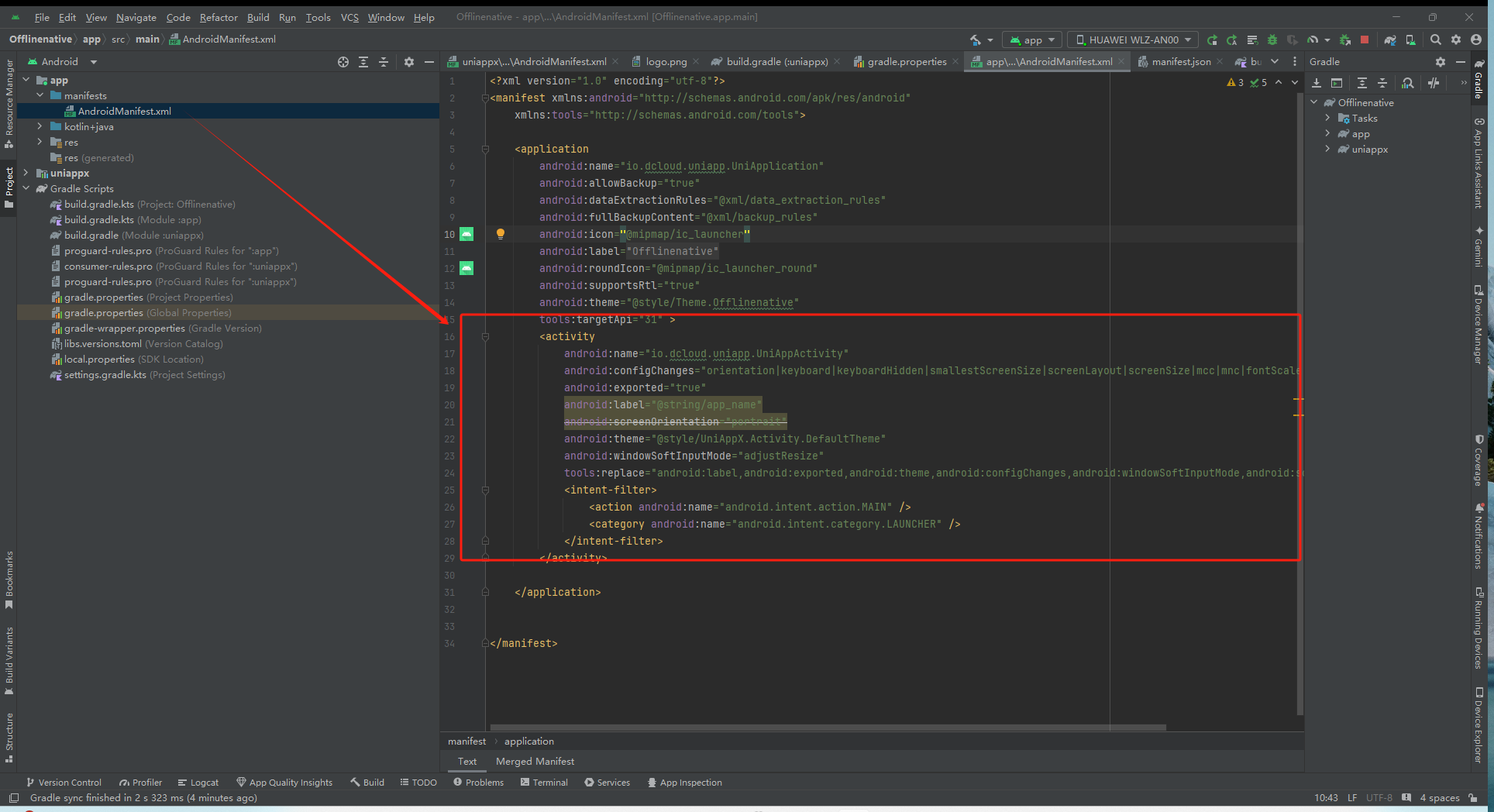Uniapp-x的离线打包
准备(我的配置)
-
HBuilder X (4.29版本及以上)
-
uniapp x SDK (4.29),是uniapp x的SDK,不要跟uniapp的搞混了,下载地址Uniapp x SDK
-
android studio (2023/2024都行)
其它:gradle版本为8.7。gradle插件版本为8.6.0。kotlin插件版本为1.9.0
1. 新建一个Android空项目
打开 android studio,点击顶部的 New Project –> Phone And Tablet –> No Activity,如下图:出现下面的界面


- Name 是你的项目名称
- Package name是你的包名
- Language 要选择 Kotlin
- Min Sdk 建议21
点击Finsh,这是空项目模板

我这里是gradle构建之后的目录,后面的都是基于构建完成的
- 一般称app为主模块,它下面的 build.gradle.kts 是主模块的编译配置文件,也是项目级别的编译配置文件,一定要跟其它的区分开来
下面的步骤就是跟官网一致了!
2. 新建uni-app x模块
点击File->New->New Module...
点击左侧Templates的Android Library。
Language选择Kotlin。
Module name建议设置为uniappx。
点击Finish。

构建之后会多出一个uniappx目录
基础库配置
- 在uni-app x模块下新建目录
libs,跟src同级别 ,将uts-runtime-release.aar,android-gif-drawable-1.2.28.aar,app-common-release.aar,app-runtime-release.aar,breakpad-build-release.aar,dcloud-layout-release.aar, framework-release.aar,uni-exit-release.aar,uni-getAccessibilityInfo-release.aar,uni-getAppAuthorizeSetting-release.aar,uni-getAppBaseInfo-release.aar, uni-getSystemSetting-release.aar,uni-openAppAuthorizeSetting-release.aar,uni-prompt-release.aar,uni-storage-release.aar,uni-getDeviceInfo-release.aar, uni-getSystemInfo-release.aar,uni-rpx2px-release.aar,uni-theme-release.aar共19个aar拷贝到libs下,参考下图

修改uniappx模块下的build.gradle
- 添加依赖
将下面的依赖信息添加到build.gradle中
dependencies {
···
implementation fileTree(include: ['*.aar'], dir: './libs')
implementation "androidx.core:core-ktx:1.10.1"
implementation "androidx.recyclerview:recyclerview:1.3.2"
implementation "androidx.appcompat:appcompat:1.0.0"
implementation "androidx.exifinterface:exifinterface:1.3.6"
implementation "androidx.localbroadcastmanager:localbroadcastmanager:1.0.0@aar"
implementation "androidx.constraintlayout:constraintlayout:2.1.4"
implementation "androidx.webkit:webkit:1.6.0"
implementation "com.google.android.material:material:1.4.0"
implementation "androidx.viewpager2:viewpager2:1.1.0-beta02"
implementation "com.alibaba:fastjson:1.2.83"
implementation "com.facebook.fresco:fresco:3.1.3"
implementation "com.facebook.fresco:middleware:3.1.3"
implementation "com.facebook.fresco:animated-gif:3.1.3"
implementation "com.facebook.fresco:webpsupport:3.1.3"
implementation "com.facebook.fresco:animated-webp:3.1.3"
implementation "com.github.bumptech.glide:glide:4.9.0"
implementation "org.jetbrains.kotlinx:kotlinx-coroutines-core:1.6.4"
implementation "org.jetbrains.kotlinx:kotlinx-coroutines-android:1.6.4"
implementation "org.jetbrains.kotlin:kotlin-stdlib:1.8.10"
implementation "org.jetbrains.kotlin:kotlin-reflect:1.8.10"
implementation "org.jetbrains.kotlinx:kotlinx-serialization-json:1.4.1"
implementation "com.squareup.okhttp3:okhttp:3.12.12"
implementation "com.github.getActivity:XXPermissions:18.63"
}
- 添加aaptOptions配置
将aaptOptions配置添加到android节点下
aaptOptions {
additionalParameters '--auto-add-overlay'
ignoreAssetsPattern '!.svn:!.git:.*:!CVS:!thumbs.db:!picasa.ini:!*.scc:*~'
}
- 修改app主模块的配置(不要漏掉了)
在build.gradle的dependencies节点添加下面两行
implementation(fileTree(mapOf("include" to listOf("*.aar"), "dir" to "../uniappx/libs")))
implementation(project(":uniappx"))

配置gradle插件
1.下载的SDK压缩包里面有一个plugins文件,将它复制到你的项目根目录

2.在项目根目录的build.gradle的顶部添加gradle插件的依赖

buildscript {
dependencies {
classpath(files("plugins/uts-kotlin-compiler-plugin-0.0.1.jar"))
classpath(files("plugins/uts-kotlin-gradle-plugin-0.0.1.jar"))
}
}- 然后在uniappx模块的build.gradle下添加插件io.dcloud.uts.kotlin的依赖

plugins {
...
id 'io.dcloud.uts.kotlin'
}修改项目的settings.gradle
- 在项目根路径下的settings.gradle中添加jitpack的maven的仓库地址和本地gradle插件的路径配置

dependencyResolutionManagement {
repositoriesMode.set(RepositoriesMode.FAIL_ON_PROJECT_REPOS)
repositories {
...
maven { url = uri("https://jitpack.io") }
flatDir { dirs('./plugins/') }
}
}
修改项目的gradle.properties
- 在项目根路径下的gradle.properties中追加如下内容

android.useAndroidX=true
android.enableJetifier=true修改app主模块下的AndroidManifest.xml
- 添加activity,将下面内容拷贝到application节点下

完成的AndroidManifest.xml如下
<?xml version="1.0" encoding="utf-8"?>
<manifest xmlns:android="http://schemas.android.com/apk/res/android"
xmlns:tools="http://schemas.android.com/tools">
<application
android:name="io.dcloud.uniapp.UniApplication"
android:allowBackup="true"
android:dataExtractionRules="@xml/data_extraction_rules"
android:fullBackupContent="@xml/backup_rules"
android:icon="@mipmap/ic_launcher"
android:label="@string/app_name"
android:roundIcon="@mipmap/ic_launcher_round"
android:supportsRtl="true"
android:theme="@style/Theme.Offlinenative"
tools:targetApi="31" >
<activity
android:name="io.dcloud.uniapp.UniAppActivity"
android:configChanges="orientation|keyboard|keyboardHidden|smallestScreenSize|screenLayout|screenSize|mcc|mnc|fontScale|navigation|uiMode"
android:exported="true"
android:label="@string/app_name"
android:screenOrientation="portrait"
android:theme="@style/UniAppX.Activity.DefaultTheme"
android:windowSoftInputMode="adjustResize"
tools:replace="android:label,android:exported,android:theme,android:configChanges,android:windowSoftInputMode,android:screenOrientation">
<intent-filter>
<action android:name="android.intent.action.MAIN" />
<category android:name="android.intent.category.LAUNCHER" />
</intent-filter>
</activity>
</application>
</manifest>
修改uniappx模块下的AndroidManifest.xml
- 添加appid,在application节点下添加
DCLOUD_UNI_APPID节点

<application>
<meta-data
android:name="DCLOUD_UNI_APPID"
android:value="你的appid" />
</application>拷贝资源文件
-
导出uni-app x项目的资源文件:选择项目,然后点击:发行 -> 原生App-本地打包 -> 生成本地打包App资源,导出成功之后会在项目的unpackage/resources目录下生成资源文件
-
将app-android目录下与appid对应的目录拷贝到uniappx的
assets/apps目录下,需要自己先创建

- 拷贝kt文件:需要将
unkackage/resource/app-android/uniappx/app-android/src/目录下的所有文件拷贝到项目的uniappx模块下的src/main/java下,src/main/java下的包名文件夹可以删掉

如果你的项目没有uts插件,到这一步已经可以使用As运行啦
配置uts插件
资源导出成功之后,uts插件资源位于unpackage/resource/app-android/uni_modules下
为方便区分,uts插件指前端封装的uni_modules插件;android uts插件指根据编译后的uts插件生成的安卓原生模块
新建android uts插件模块,跟新建uniappx一样,下面以插件wow-scankit为例子,下面所有都是基于wow-scankit的配置示例

-
点击左侧Templates的Android Library。
-
Language选择Kotlin。
-
Module name建议与uts插件模块名称一致。
-
点击Finish。
注意:
- Templates一定要选择Android Library。
- Language一定要选择Kotlin。
- Build configuration language建议选择Groovy DSL(build.gradle)。以下教程均按照此模式进行
添加gradle插件
- 在
`wow-scankit插件模块的build.gradle的plugins节点下添加io.dcloud.uts.kotlin的依赖
plugins {
...
id 'io.dcloud.uts.kotlin'
}- 添加依赖
将下面内容拷贝到build.gradle中,添加到原有的dependencies节点,不要删掉原有的
dependencies {
compileOnly fileTree(include: ['*.aar'], dir: '../uniappx/libs')
compileOnly fileTree(include: ['*.aar'], dir: './libs')
compileOnly "com.alibaba:fastjson:1.2.83"
compileOnly "androidx.core:core-ktx:1.10.1"
compileOnly 'org.jetbrains.kotlinx:kotlinx-coroutines-core:1.3.8'
compileOnly 'org.jetbrains.kotlinx:kotlinx-coroutines-android:1.3.8'
}
根据config.json配置应用
如果uts插件的config.json有内容
下面是插件wow-scankit的配置
minSdkVersion
在插件wow-scankit的android节点的defaultConfig的minSdk设置此字段
{
"minSdkVersion": "21",
"dependencies": ["com.huawei.hms:scan:2.12.0.301"]
}dependencies
在插件wow-scankit的dependencies 添加 implementation 'com.huawei.hms:scan:2.12.0.301'

- 在项目的
settings.gradle.jks文件需要添加仓库地址

完整的dependencyResolutionManagement如下
dependencyResolutionManagement {
repositoriesMode.set(RepositoriesMode.FAIL_ON_PROJECT_REPOS)
repositories {
google()
mavenCentral()
maven {
url = uri("https://jitpack.io")
}
maven {
url = uri("https://developer.huawei.com/repo/")
}
flatDir {
dirs("./plugins/")
}
}
}- 将插件添加到
uniappx模块

implementation project(":wow-scankit")复制资源(如果有就复制)
libs
将src目录下的所有文件拷贝到android uts插件模块/src/main/java目录下(wow-scankit插件没有)
assets
将assets文件夹拷贝到wow-scankit插件模块/src/main/目录下
res
将res文件夹拷贝到wow-scankit插件模块/src/main/目录下。
AndroidManifest.xml
将AndroidManifest.xml拷贝到wow-scankit插件模块/src/main/目录下
添加到主项目
将wow-scankit插件模块的依赖添加到uniappx模块的build.gradle的依赖中

implementation project(':wow-scankit')配置完成后重新构建




14 个评论
要回复文章请先登录或注册
3***@qq.com
3***@qq.com
蔡cai
l***@126.com
晒网
4***@qq.com
糯米dmyz
8***@qq.com
s***@outlook.com
[已删除]